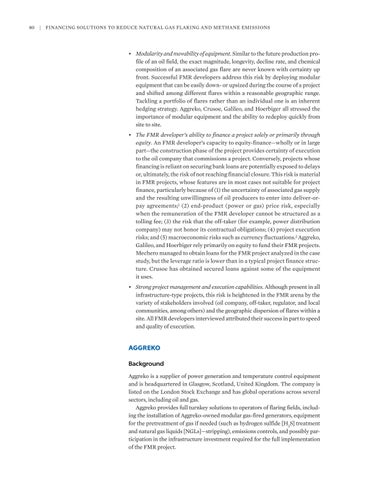80
| Financing Solutions to Reduce Natural Gas Flaring and Methane Emissions
• Modularity and movability of equipment. Similar to the future production profile of an oil field, the exact magnitude, longevity, decline rate, and chemical composition of an associated gas flare are never known with certainty up front. Successful FMR developers address this risk by deploying modular equipment that can be easily down- or upsized during the course of a project and shifted among different flares within a reasonable geographic range. Tackling a portfolio of flares rather than an individual one is an inherent hedging strategy. Aggreko, Crusoe, Galileo, and Hoerbiger all stressed the importance of modular equipment and the ability to redeploy quickly from site to site. • The FMR developer’s ability to finance a project solely or primarily through equity. An FMR developer’s capacity to equity-finance—wholly or in large part—the construction phase of the project provides certainty of execution to the oil company that commissions a project. Conversely, projects whose financing is reliant on securing bank loans are potentially exposed to delays or, ultimately, the risk of not reaching financial closure. This risk is material in FMR projects, whose features are in most cases not suitable for project finance, particularly because of (1) the uncertainty of associated gas supply and the resulting unwillingness of oil producers to enter into deliver-orpay agreements;1 (2) end-product (power or gas) price risk, especially when the remuneration of the FMR developer cannot be structured as a tolling fee; (3) the risk that the off-taker (for example, power distribution company) may not honor its contractual obligations; (4) project execution risks; and (5) macroeconomic risks such as currency fluctuations.2 Aggreko, Galileo, and Hoerbiger rely primarily on equity to fund their FMR projects. Mechero managed to obtain loans for the FMR project analyzed in the case study, but the leverage ratio is lower than in a typical project finance structure. Crusoe has obtained secured loans against some of the equipment it uses. • Strong project management and execution capabilities. Although present in all infrastructure-type projects, this risk is heightened in the FMR arena by the variety of stakeholders involved (oil company, off-taker, regulator, and local communities, among others) and the geographic dispersion of flares within a site. All FMR developers interviewed attributed their success in part to speed and quality of execution.
AGGREKO Background Aggreko is a supplier of power generation and temperature control equipment and is headquartered in Glasgow, Scotland, United Kingdom. The company is listed on the London Stock Exchange and has global operations across several sectors, including oil and gas. Aggreko provides full turnkey solutions to operators of flaring fields, including the installation of Aggreko-owned modular gas-fired generators, equipment for the pretreatment of gas if needed (such as hydrogen sulfide [H2S] treatment and natural gas liquids [NGLs]—stripping), emissions controls, and possibly participation in the infrastructure investment required for the full implementation of the FMR project.


